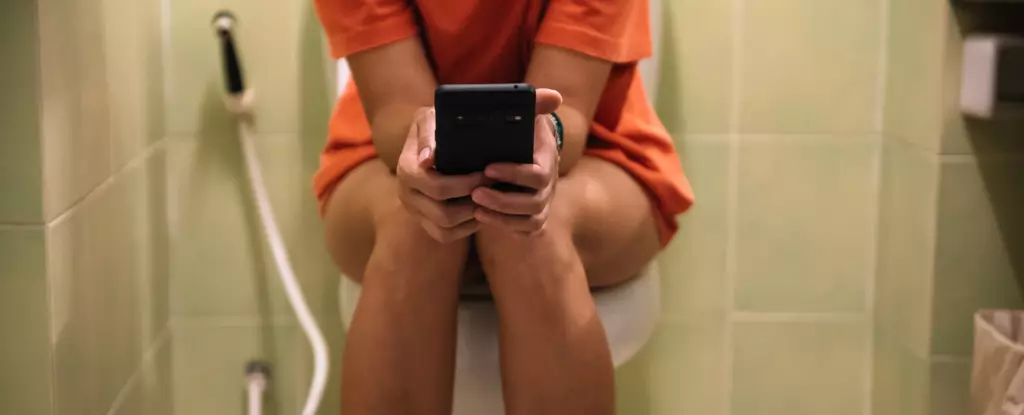In today’s fast-paced, technology-driven world, our bathrooms have transformed into more than just personal sanctuaries; they have become infamous sanctuaries where we bury ourselves in our smartphones. It’s a widespread practice to scroll through feeds or read articles while on the toilet, but this seemingly innocuous habit may come with alarming consequences. A recent survey presented at the Digestive Diseases Week (DDW) conference drew a stark connection between this bathroom behavior and a 46 percent increased risk for hemorrhoids. Yes, you read that correctly. While it’s easy to laugh at the absurdity of it all, it’s imperative to address the seriousness of the implications lurking behind our casual toilet habits.
Despite the playful connotation associated with reading on the toilet, a troubling trend emerges. The survey identified that more than 40 percent of participants had hemorrhoids, and a staggering 93 percent admitted to using their phones during bathroom visits. What’s even more concerning is that nearly half of these individuals reported spending more than six minutes per session. This certainly raises eyebrows on whether our basic bodily functions are being thwarted by technology’s seductive grasp. The bathroom, a previously sacred space for private moments, is now often overshadowed by the incessant glow of screens.
The Hidden Cost of Extended Bathroom Visits
While the idea of spending time in the bathroom with a smartphone may seem trivial, the potential health repercussions are severe. Hemorrhoids, though relatable through humor and discomfort, are likely the product of our tech-induced procrastination. Prolonged sitting on the toilet—a direct result of our need to scroll—may dilate and strain blood vessels, leading to painful consequences. Traditional guidelines suggest limiting our bathroom stays to ten minutes, while some experts advise a maximum of three minutes based on concrete studies linking extended sitting to increased risk of hemorrhoids. In short, while we may be seeking a break from our daily grind, we could inadvertently be inviting more significant issues into our lives.
The cultural nuances surrounding bathroom habits have also evolved. In colonial times, people relied on newspapers, as impractical as that may sound today. However, phones take the idea of distraction to another level. The infinite scroll of social media provides us not just with content but also with distraction from the task at hand—an unfortunate irony considering that we have a biological imperative to relieve ourselves. While we’re lost in the digital maze, the body becomes stressed.
The Call for a Smartphone-Free Zone
With the possibility of compelling health risks emerging from our toilet scrolling, it begs the question: Is it time to declare our bathrooms as smartphone-free zones? While the notion may seem radical to the tech-obsessed, dismissing this idea could eventually lead to more bouts with discomfort or chronic issues. Experts are now warning that our “toilet hygiene” could greatly benefit from a detox from all things digital. They argue that the physiological act of using the toilet should not be sullied by distractions that pull our attention away from what’s fundamentally important.
As effective as it may seem to multitask in the privacy of our own bathrooms, we’re undermining both our health and an age-old practice that once prioritized bodily functions over social media validation. Prioritizing time spent in the bathroom for what it truly represents—relief—rather than a platform for entertainment is vital. The time may have come for us to reclaim our restrooms, embracing their original functionality devoid of clickbait or Instagram content.
Hygiene and Health in the Digital Age
It’s crucial to acknowledge that we exist in an era shaped by rapid technological evolution. However, this does not excuse us from understanding the fine line between convenience and harassment—especially when it comes to our health. As humorous as the consequences of our digital dependencies may be, like any health issue, negligence poses a risk that is deeply consequential. The appropriate action requires a cultural shift in how we perceive our bathroom habits.
Next time you find yourself in the bathroom, consider whether your phone should be your companion or if the moment is better served as a break from distractions. Redirecting our attention to our biology could very well save us from future distress and ease our strained vessels. All good things must come to an end, and that includes our bathroom breaks for the sake of convenience. Engaging with our bodies—and perhaps rediscovering the missed opportunities in moments of solitude—could revolutionize how we approach something as routine as using the restroom.



Leave a Reply